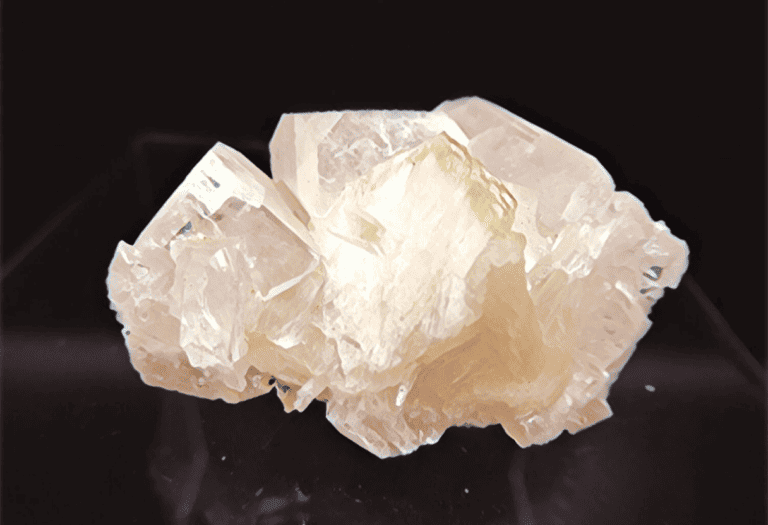Discovering the rare gemstone painite is like finding a needle in a haystack.
It’s one of the world’s most elusive minerals, but you can learn to spot it with the right knowledge. If you’re curious about this precious find, you’re in luck.
Knowing what to look for is key when identifying painite. You’ll need to be familiar with its unique characteristics, from color to crystal structure.
Get ready to embark on a journey into the world of gemstones, where you’ll become a painite pro in no time.
To identify painite, check for its reddish-brown hue, hexagonal crystals, and glass-like luster. It should leave a white streak, show no magnetic response, and scratch glass, indicating a Mohs hardness of 8-8.5. Painite exhibits weak birefringence, is translucent to opaque, and has a specific gravity of 4.00-4.03.
How to Identify Painite Through Testing
Visual Inspection
To start your hunt for painite, you’ll rely heavily on visual clues. You’re looking for a gemstone that typically displays a brown to reddish-brown hue, sometimes with a hint of purple. Painite crystals are often hexagonal and may show a glass-like luster. Keep an eye out for their unique, well-formed crystal structure which is a telltale sign you might be onto something special.
The Streak Test
Scratch the mineral across an unglazed porcelain plate, and you’ll see the true color of a mineral’s streak. For painite, it’s usually white or colorless. This test is highly valuable because the streak color remains consistent regardless of the mineral’s exterior coloration.
Magnet Test
While painite itself isn’t magnetic, impurities within the stone, like iron, might respond to a magnet. If you’re noticing a slight magnetic reaction, it’s worth investigating further, although a lack of magnetism doesn’t rule painite out.
Hardness Test
Painite is known for its significant hardness, rating between 8-8.5 on the Mohs scale. You’ll use simple tools like a steel file or glass to test the gemstone’s resistance to being scratched. If the suspect stone can scratch glass and remains unaffected by a steel file, you could be handling painite.
Birefringence Test
Using a petrographic microscope, check for birefringence, an optical property seen in some minerals where light is split into two rays. Painite exhibits weak birefringence, so if your sample shows this trait, it’s another positive sign.
Checking The Diaphaneity
Painite can range from transparent to translucent. You’re checking how light passes through the stone. Holding it up to a light source will reveal its transparency level and potentially confirm its identity.
Single or Double Refraction
Shine a beam of light through the gem and examine its path. Painite exhibits single refraction, meaning the light should travel through as a single ray. This characteristic helps differentiate painite from other similar-looking minerals.
Refractive Index Test
A refractometer gives you the refractive index—a measure of how much light is bent as it enters the gemstone. Painite has a refractive index of about 1.81 to 1.85. If you record values within this range, it reinforces the likelihood that you’ve found painite.
Finding The Specific Gravity
The specific gravity of painite falls between 4.00 and 4.03. This test involves measuring the weight of the gem in air versus its weight when suspended in water. Accurate scales and calculations can confirm if your specimen falls within the perfect range for painite.
Identifying Painites in the Field
When you’re searching in the field, keep in mind the typical environments where painite is found. Look around limestone deposits and marble, particularly in regions known to produce painite. Keep your eyes peeled for the characteristic glistening, hexagonal crystals amidst the surrounding rock.
Recognizing Potential Painite Rocks
To identify potential painite rocks, you’ll need to bring together all the testing techniques you learned. Start with a visual assessment, followed by streamlined tests like the streak test and magnet test, moving on to more specialized assessments as needed. Remember, successful identification relies on a combination of these methods, so leave no stone unturned in your quest to uncover this elusive mineral.
Physical Characteristics of Painite

When you’re on the hunt for painite, it’s vital to become familiar with its physical characteristics. Painite has distinctive features that set it apart from other minerals.
Color is a crucial identifier for painite; the stone typically showcases hues ranging from brown to reddish-brown. Certain specimens may exhibit a pleasant pinkish hue. The luster of painite is another telltale sign; it’s noted for its submetallic to resinous shine, which helps in distinguishing it from similar minerals.
The crystal structure of painite is also unique. It crystallizes in the hexagonal system, exhibiting prismatic and tabular shapes. Observing the crystal habit can often be enough to signal the presence of painite, especially to those who’ve gained some experience in gemstone identification.
- Color Variation: Brown to Reddish-Brown, sometimes Pink
- Luster: Submetallic to Resinous
- Crystal System: Hexagonal
- Crystal Habit: Prismatic, Tabular
The hardness of painite rates between 8 and 8.5 on the Mohs scale, positioning it among the harder gemstones. This attribute not only contributes to its identification but also to its desirability as a gemstone due to its durability.
Density is another physical property to consider. Painite has a specific gravity between 3.72 and 4.05, which is significantly higher than that of most common gemstones. To put this in perspective, diamonds, renowned for their hardness, have a specific gravity of approximately 3.52.
By recognizing these physical traits and recalling their typical environments, you’ll be well-equipped to identify potential painite samples before progressing to more complex testing methods.
How Are Painite Formed?
Painite holds a reputation as one of the rarest minerals on Earth, and its formation process is a fascinating tale of geology. Born in environments rich with boron, this gemstone is typically found where crustal rocks have been extensively altered by high-pressure, high-temperature fluids. These extreme conditions are essential for painite to crystallize and are often associated with the contact metamorphic zones surrounding intrusive igneous rocks.
Limestone and marble units deeply embedded within these zones provide the calcium, while boron likely comes from serpentine-rich terrains or evaporated deposits. Painite forms when these elements are exposed to the right cocktail of pressure, heat, and fluid, fostering a unique environment for crystal growth. In other words, painite needs an alchemy of geological processes to come into existence.
Discovering painite in its natural habitat entails surveying areas known for their host rocks and metamorphic histories. Countries such as Myanmar have provided a fruitful hunting ground for this scarce mineral, primarily because of the geology that aligns with the known formation requirements of painite.
Mineral collectors and geologists often hunt for this rare gem in alluvial deposits. These are sediments that are eroded and transported by water from their primary locations, suggesting that the original source—painite bearing rock—still awaits discovery in the vicinity.
Understanding how painite is formed leads to better identification strategies. Knowing that it emerges from such specialized conditions, you’re equipped with the knowledge that finding painite is as much about where you look as it is about the tests you conduct to confirm its identity.
Preparation for Painite Hunting
When embarking on a journey to find the elusive painite, being well-prepared with the right equipment and safety measures is crucial. You’ll need to consider not only the tools necessary for identification but also the gear that will keep you safe during your search.
Gathering the Right Tools
Proper equipment is the backbone of any successful mineral hunt. To ensure you’re well-equipped for identifying painite, here’s a list of essentials:
- Magnifying glass or jeweler’s loupe: To inspect stones closely.
- Field guide to minerals: Helps you compare findings with known characteristics.
- Hardness testing kit: Includes picks for performing scratch tests.
- Streak plate: For observing the color of the mineral’s powder.
- Dichroscope: Useful for determining pleochroism, a feature in painite.
- Portable electronic scale: To measure specific gravity on-site.
- UV light: Some minerals have fluorescent properties.
- Notebook and pen: Keep detailed records of your findings.
- GPS device or maps: Ensures you don’t lose your way in remote locations.
Remember to pack spare batteries for electronic devices and consider the weather conditions of the area you’ll be exploring.
Safety Considerations
Safety should never be an afterthought. Here are some tips to protect yourself while painite hunting:
- Wear protective gear: This includes gloves, safety goggles, and a helmet if you’re entering mine areas or rocky environments.
- Durable clothing: Long-sleeved shirts and pants shield you against cuts and scrapes.
- Sturdy boots: Protect your feet and prevent slips or falls.
- First aid kit: Always have it on hand for unexpected injuries.
- Water and snacks: Stay hydrated and energized, especially in remote and arid regions.
- Inform someone of your plan: Let someone know where you’re going and when you plan to return.
- Emergency whistle or flare: To signal for help if needed.
Exploring areas with painite potential requires you to be aware of local wildlife, weather hazards, and any legal restrictions on mineral collection. Research these before setting out to ensure that your hunting adventure is not just fruitful but also legal and environmentally conscious.
Handling and Care of Found Painite

Cleaning Painites
Once you’ve unearthed a potential painite specimen, it’s crucial to gently clean the gemstone to examine its true colors and features. Avoid harsh chemicals and scrubbing, as these can damage the stone’s surface. Instead, use a soft brush and mild soap in lukewarm water to remove any dirt or debris. Air drying is recommended to prevent any unwanted scratches that towel drying might cause. Be mindful that despite painite’s considerable hardness, it’s not impervious to chipping or cracking through rough handling.
Storing Painites
After cleaning, ensuring the proper storage of your painite is essential for maintaining its pristine condition. Wrap each gemstone individually in a soft cloth or place it in a padded gem jar. This will prevent any contact with other minerals or hard surfaces that could cause scratches. Consistent temperature and humidity-controlled environments are ideal to prevent any potential damage from extreme conditions. Moreover, when transporting painites, secure them in a cushioned container to protect from shocks and vibrations that could lead to fractures.
Displaying Painites
Should you decide to showcase your painite, select a display case that limits exposure to direct sunlight, as prolonged UV radiation can affect the gemstone’s color. Opt for indirect lighting to highlight the painite’s natural brilliance without risk. Additionally, consider using a rotation system if displaying multiple specimens, to evenly distribute any potential light damage over time.
Handling Precautions
When handling painites, always remember that natural gemstones can be delicate. Use soft gloves to avoid the natural oils from your skin affecting the luster. Ensure that you have a secure grip, as dropping a painite could lead to chipping. Take note that even though painite ranks high on the Mohs scale of hardness, it isn’t as tough as diamonds, making careful handling a priority.
Conclusion: Confirming Painite is Real
You’ve now got the tools you need to confirm whether that intriguing stone is indeed a rare painite.
Remember, it’s all about the details—from the visual cues to the more involved tests. Your newfound knowledge of painite’s unique properties will serve you well as you handle and care for these precious gems. Armed with this information, you’re ready to identify, appreciate, and safeguard your painite specimens.
So go ahead, put your skills to the test, and enjoy the thrill of discovering one of the world’s rarest minerals.


![PA Rockhounding Sites in [year]: Spots & Treasures](https://observationhobbies.com/wp-content/uploads/2024/01/Tga-ze11rwaKDz9VFfT9I-768x439.jpg)

![Setting Prices for Handmade Jewelry [year]](https://observationhobbies.com/wp-content/uploads/2024/01/dVTRvDJ0W4koSsyHjCF9V-768x439.jpg)


